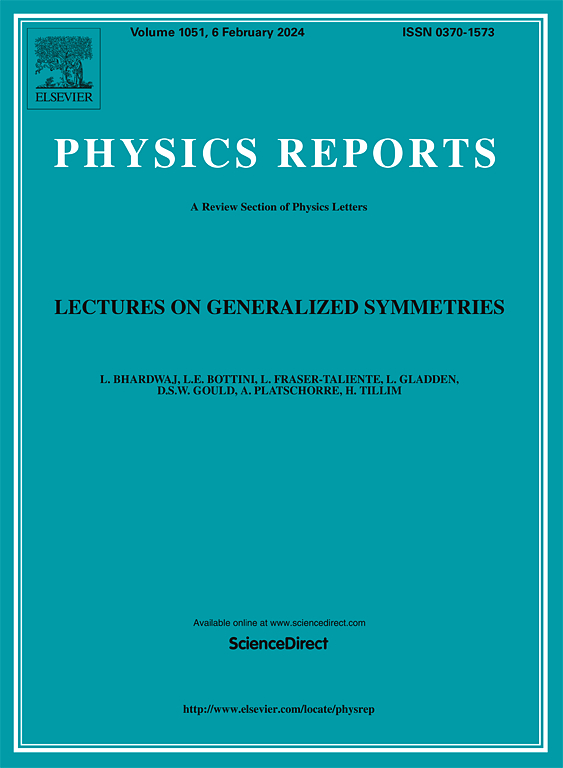The energy level spectrum of the yellow excitons in cuprous oxide
IF 29.5
1区 物理与天体物理
Q1 PHYSICS, MULTIDISCIPLINARY
引用次数: 0
Abstract
This article discusses the experimental status achieved in the assessment of the hydrogen-like series of Wannier–Mott excitons, using the semiconductor cuprous oxide, CuO, as material platform. While for other crystals the observed exciton series are limited to low principal quantum numbers and typically a particular orbital angular momentum , recently a major extension of the number of detected states has been achieved for the so-called yellow exciton series in cuprous oxide. About 60 quantum number combinations , defining different shells of possible exciton states, were detected in high-resolution one-photon absorption and second harmonic generation spectroscopy, also complemented with application of external electric or magnetic fields. The extension concerns not only the optically active states (the orthoexcitons) that are allowed in different orders of light–matter coupling, but also the states that are optically forbidden due to spin conservation in optical transitions (the paraexcitons). The hydrogen model provides a good overall description of the exciton level spectrum. However, an analysis with sufficient energy resolution reveals significant deviations evidenced by shell splittings, which arise from breaking of the rotational into discrete symmetries in the cubic crystal environment. The resulting fine structure splitting between different shells and within a shell is mainly determined by the valence band dispersion in CuO showing pronounced band mixing effects. The corresponding extensions in the exciton Hamiltonian bear similarity to those causing the fine structure splitting in hydrogen, namely a higher order kinetic energy term and a spin–orbit coupling term. In addition, the electron–hole exchange interaction arising for the orthoexcitons and corrections to the dielectric screening provide further contributions to the fine structure splitting. As a consequence, the hydrogen wavefunctions are valid only approximately for describing excitons, being in fact coupled in the exciton envelopes. Despite the broken -degeneracy of the exciton levels, further symmetry protected degeneracies remain, which can be removed by applying external fields. We describe the evolution of the fine structure spectrum in electric and magnetic fields towards Stark ladders and Landau fans, respectively. The optical spectra depend on the crystal orientation relative to the external field in addition to their dependence on the chosen optical axis. Also, the deviations from an isotropic medium become obvious, as the symmetry reduction and the resulting state coupling lead to avoided crossings when levels come into field-induced resonance. Applying the field such that all symmetries are broken, quantum chaos is observed in the state range with principal quantum numbers exceeding , as evidenced by observing exclusively anticrossings at state resonances. The synopsis of the data shows that high resolution exciton spectroscopy has reached a level of accuracy that approaches that of atomic systems.
氧化亚铜中黄色激子的能级谱
本文讨论了以半导体氧化亚铜(Cu2O)为材料平台,在评估类氢系列万尼尔-莫特激子方面所取得的实验成果。对其他晶体而言,所观测到的激子系列仅限于低主量子数 n 和典型的特定轨道角动量 L,而最近对氧化亚铜中所谓的黄色激子系列而言,所检测到的状态数量有了重大扩展。在高分辨率单光子吸收和二次谐波发生光谱中检测到了约 60 种量子数组合 (n,L),这些量子数组合定义了可能的激子状态的不同外壳,同时还辅以外部电场或磁场。这一扩展不仅涉及在不同光-物质耦合阶数下允许存在的光学活性状态(正激子),还涉及由于光学转换中的自旋守恒而被光学禁止的状态(副激子)。氢模型能很好地全面描述激子水平谱。然而,在进行具有足够能量分辨率的分析时,会发现由于立方晶体环境中的旋转离散对称性被打破而产生的壳分裂(shell splittings)所证明的重大偏差。由此产生的不同壳之间以及一个壳(n,L)内的精细结构分裂主要由 Cu2O 中的价带色散决定,显示出明显的带混合效应。激子哈密顿中的相应扩展与氢中导致精细结构分裂的扩展相似,即高阶动能项和自旋轨道耦合项。此外,正交激子产生的电子-空穴交换相互作用和介电屏蔽修正也对精细结构分裂做出了进一步的贡献。因此,氢波函数仅对描述激子近似有效,实际上在激子包络中是耦合的。尽管激子水平的 L 退化被打破,但仍存在进一步的对称保护退化,这些退化可以通过施加外部场来消除。我们描述了精细结构光谱在电场和磁场中分别向斯塔克梯形和朗道扇形演变的过程。除了与所选光轴有关之外,光学光谱还取决于晶体相对于外部磁场的取向。此外,与各向同性介质的偏差也变得非常明显,因为对称性降低和由此产生的状态耦合会导致避免在水平进入场致共振时发生交叉。在所有对称性都被打破的情况下施加场,在主量子数超过 n=5 的状态范围内观察到量子混沌,在状态共振处观察到的完全是反交叉就证明了这一点。数据概要表明,高分辨率激子光谱学已达到接近原子系统的精确水平。
本文章由计算机程序翻译,如有差异,请以英文原文为准。
求助全文
约1分钟内获得全文
求助全文
来源期刊

Physics Reports
物理-物理:综合
CiteScore
56.10
自引率
0.70%
发文量
102
审稿时长
9.1 weeks
期刊介绍:
Physics Reports keeps the active physicist up-to-date on developments in a wide range of topics by publishing timely reviews which are more extensive than just literature surveys but normally less than a full monograph. Each report deals with one specific subject and is generally published in a separate volume. These reviews are specialist in nature but contain enough introductory material to make the main points intelligible to a non-specialist. The reader will not only be able to distinguish important developments and trends in physics but will also find a sufficient number of references to the original literature.
 求助内容:
求助内容: 应助结果提醒方式:
应助结果提醒方式:


